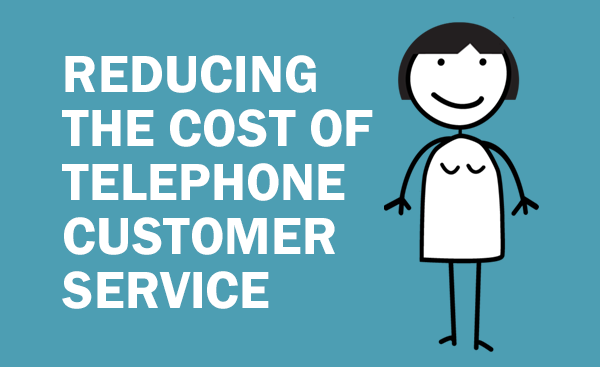Reducing the cost of telephone customer service

Despite the rise of digital channels and the growth of multichannel customer service, the telephone remains vital for businesses and consumers. In fact, while customers are certainly increasing their use of online self-service resources, web chat and social, research from Forrester indicates that 73% still use the phone for customer service.
However, one of the biggest issues with telephone customer service has been the resources it requires – particularly in terms of agent and consumer time. Costs are now going to be much more visible, thanks to the new UK Calling initiative. This regulation means that businesses will have to show how much customers are being charged when they call an organization through an 084, 087, 09 or 118 number – known in the industry as ‘service numbers’. UK telecoms regulator Ofcom, has referred to this regulation as “the biggest change to telephone calls in over a decade”.
The hidden costs of calls
In the past, callers to service numbers were not generally told how much they were being charged – nor made aware that some of the numbers were premium rate lines. In fact Ofcom research has indicated that every year, callers in the UK spend a total of 250m hours calling these numbers, shelling out around £900m altogether.
The cost for calling these numbers usually comprises an access charge payable to the callers’ phone provider and a service charge decided by the organization receiving the calls. The UK Calling initiative requires that both these charges are now made clear separately on a consumer’s phone bill and contracts, and in any marketing materials from service providers that use the numbers.
So if you offer customer service through these numbers, people can see how much it is costing them and how much you as a company are making out of it – which could potentially put them off doing business with you.
The alternative is to avoid using service numbers and offer customers the option of making contact via a Freephone number – where you, as the company, pay all costs. However, this could well add to costs, both by increasing the number of calls you receive and removing a source of revenue from the service number that previously offset your contact center costs.
Balancing this budget change is difficult. So how can you deliver better telephone service while minimizing costs? Here are key main ways:
1. Cut call volumes
Many phone calls are made because people simply can’t find the information they need anywhere else. The answer to reducing these avoidable calls is to put web self-service in place on your site. This provides an easy to use way of answering all their potential questions quickly and accurately without consumers having to resort to phoning in, freeing up agent time for more complex enquiries. Importantly, you also need to work hard to ensure you tell customers you have self-service resources available – make it clear to them on your website, marketing materials, and when they dial into the contact center. Web self-service can boost efficiency by cutting inbound call numbers, while at the same time improving satisfaction – because people get accurate answers quicker, without having to change channels to get the information they need.
2. Shorten call times
By empowering agents with a good quality centralized knowledge management system that gives agents fast, accurate answers to a comprehensive list of customer questions, you can reduce the length of customer calls while improving satisfaction. This knowledge base should give agents the answers they need at their fingertips, allowing them to deliver responses more quickly. It avoids the need to put callers on hold while they try to hunt around for information and increases consistency as all answers come from a single source.
3. Increase First Contact Resolution rates
Customers hate it if their query cannot be successfully dealt with when they call in. Therefore improving First Contact Resolution rates in order to cut costs and increase customer satisfaction is a prime objective of any contact center. However, in many cases agents often have to call back as they can’t give a comprehensive answer first time. So, as well as supporting agents with a comprehensive, easy to use, internal knowledge management system, you need to ensure your back and front office applications are fully joined-up to give an all-round view of the customer. The aim is to give agents easy access to everything they need fully respond to a customer on the first call.
4. Switch to chat
Another way to reduce call numbers – and to make telephone service more efficient and less costly to operate – is to encourage customers who might have phoned in to contact you via web chatinstead. Chat provides the immediacy of a telephone call by delivering a real-time, back and forth interaction. It means that consumers don’t need to switch channel from your website to the phone and can be integrated seamlessly into the customer journey. From a company point of view it allows agents to interact with multiple customers at the same time, making it much more efficient and cost effective than the telephone. In fact, a 2013 survey by Econsultancy found that web chat had the highest satisfaction levels for any customer service channel, scoring 73%, compared with 61% for email and 44% for phone. Speed (79%) and efficiency (46%) were the top reasons given for its popularity.
The fact is that the telephone channel isn’t going to go away anytime soon, even though a growing number of consumers are starting to use other channels for customer service. So you need to make sure that the telephone continues to have an important place in your customer service armory. The UK Calling Initiative will either force organizations to reduce the revenues they make from service numbers – or to move to delivering service via Freephone numbers so as not to be seen to be profiting from their customers’ calls.
Either way there is pressure to make telephone customer service more efficient by finding ways to reduce avoidable calls and to reduce the length of those calls that do come in to ensure you are operating effectively. The UK Calling Initiative serves as a handy opportunity for organizations to revisit their telephone strategies and ensure they better meet customer needs.







Comments